"The Story of an Hour" Characters
nikolonapetrova / Getty Images
- Study Guides
- Authors & Texts
- Top Picks Lists
- Best Sellers
- Plays & Drama
- Shakespeare
- Short Stories
- Children's Books
- M.A., English Literature, California State University - Sacramento
- B.A., English, California State University - Sacramento

Study Guide
"The Story of an Hour" is an 1894 short story by Kate Chopin. It's is one of her most famous short works, partly because of its surprise ending but also due to its underlying feminist theme.
The characters in " The Story of an Hour " interact very little, and much of the action happens in Louise Mallard's imagination. In fact, in its original publication this story was titled "The Dream of an Hour." How each character perceives what is happening builds to a plot twist near the end, and the tragic (or is it?) outcome.
- Louise Mallard (Mrs. Mallard): In the story, she's referred to by her married name, which suggests how closely her identity is connected to her husband. We learn she has "heart trouble." She shuts herself up in her room when she finds out her husband is dead.
- Brently Mallard (Mr. Mallard): Married to Mrs. Mallard, he is believed to be dead in a train accident. We see little of him until the final paragraph, but learn he may be controlling toward his wife, with indirect references to how a person tries to bend the will of another.
- Josephine: Louise Mallard's sister, who breaks the news of Brently Mallard's death to his wife. Josephine holds her sister while she weeps with "with sudden, wild abandonment," and implores Mrs. Mallard to come out when she retreats to her room to contemplate the situation.
- Richards: Brently Mallard's friend. He was in the newspaper office when the news of the train accident arrived. After confirming the news, he went to Mrs. Mallard's house to pass on what he had learned.
Below are some questions to consider when studying "The Story of an Hour." This is just one part of the study guide series on this short story. Please see below for additional helpful resources.
- What is Louise Mallard's mood, versus what her sister thinks it is?
- Can we read Louise Mallard's "heart trouble," beyond the literal meaning? What could that mean in the context of Mrs. Mallard's relationship with her husband?
- What was the "something coming to her"?
- 'The Story of an Hour' Questions for Study and Discussion
- Analysis of "The Story of an Hour" by Kate Chopin
- Quotes From 'The Story of an Hour' by Kate Chopin
- 42 Must-Read Feminist Female Authors
- 'The Devil and Tom Walker' Study Guide
- The Monkey's Paw: Synopsis and Study Questions
- Harriet the Spy by Louise Fitzhugh
- The Story of Jessie Redmon Fauset
- 'A Rose for Emily' Questions for Study and Discussion
- The Story of Semele
- 'A Streetcar Named Desire' — Scene 11
- Analysis of 'Paranoia' by Shirley Jackson
- The Myth of Cupid and Psyche
- Romeo and Juliet From 'Beautiful Stories From Shakespeare'
- Empress Carlota of Mexico
- "A Simple Heart" by Gustave Flaubert Study Guide
The Story of an Hour by Kate Chopin | Characters, Summary, Analysis, Setting, Theme
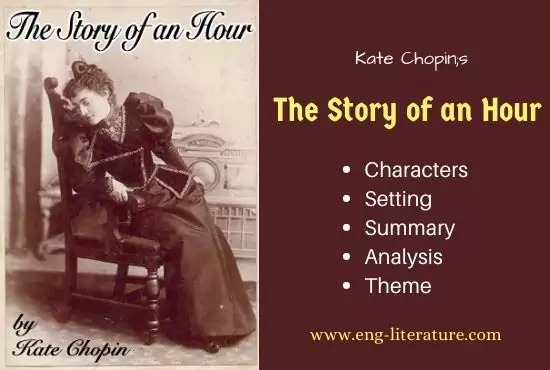
The Story of an Hour Short Story
Table of Contents
Introduction
The Story of an Hour is a phenomenal American short story written by Kate Chopin on April 19, 1894, and published in Vogue on December to 1894. Initially, it was written and first published under the title “ The Dream of an Hour “. It was reprinted in St. Louis Life on January 5, 1895.
The title of the short story refers to the time elapsed between the moments at which the protagonist, Louis Mallard , hears that her husband is dead and discovers that he is alive after all. The Story of an Hour was considered controversial during the 1898-s because it deals with a female protagonist who feels liberated by the news of her husband’s death. In Unveiling Kate Chopin, Emile Toth argues that Chopin “had to have her heroine die” in order to make the story publishable.
The Story of an Hour Setting
The Story of an Hour has been strongly linked with the ideals of the women’s liberation movement of the 1960’s when feminists took a stand to fight to give women more freedom in America. The reason “The Story of an Hour” was an important piece of literary work at this time was because of its radical story. In the story, this housewife who has been confined to the social norms of the obedient wife, has an unorthodox reaction to the death of her husband she anticipates her newfound freedom from the suppression of the husband, of men and becomes invigorated by it. This idea is one of the key values of the bus The Story of an Hour” was an important work to show a woman’s break from the norm of society.
Marriage Vs Freedom Theme
The idea of Marriage Vs. Freedom is a growing theme in modern American Women Writing during Kate Chopin’s time. The idea that women can look beyond marriage as their lifelong goal to achieve is a teetering idea for women seeking independence.
Mrs. Mallard believes that both women and men limit each other in matrimony. She does not express any apparent ill-will against Mr. Mallard and has even admitted to loving him at some points. Due to its structure as telling the situation within an hour’s time, no background information is given about Mr. and Mrs. Mallard’s relationship. This is an effective style that Chopin utilizes. The story is not about the husband being abusive to his wife or vice-versa. Instead, it focuses on the individual’s inner desires for freedom. The point of view of The Story of an Hour is that of the wife. Louise’s desire for freedom far exceeds her love for him a controversial idea that goes against the norms of society. She would rather live freely than be in a marriage that subjects her to domesticity. “There would be no powerful will bending hers in that blind persistence with which men and women believe they have a right to impose a private will upon a follow-creature”.
The Story of an Hour Summary
The short story describes the series of emotions Louis Mallard endures after hearing of the death of her husband, who was believed to have died in a railroad disaster. Mrs. Mallard suffers from heart problems and therefore her sister attempts to inform her of the horrific news in a gentle way. Mrs. Mallard locks herself in her room to immediately mourn the loss of her husband. However, she begins to feel on unexpected sense of exhilaration. “Free ! Body and soul free !” is what she believes is a benefit of his death. At the end of the story, it is made known that her husband was not involved in the railroad disaster and upon his return home Mrs. Mallard suddenly dies. The cause of her death is ambiguous and left for analysis as it can range from her known heart problems to psychological factors. We can ask ourselves if the real reason for the death was known that she would not be free after she sees that her husband isn’t really dead.
The Story of an Hour Characters
Mrs. louise mallard.
Mrs. Louise Mallard is the protagonist of the story. Si introduced as being “afflicted with a heart trouble”, which is who great care is taken in telling her of her husband’s death. She mour her husband, but then begins to feel relieved and liberated.
Mr. Brently Mallard
Mr. Brently Mallard is the husband of Louise Mallard. He is assumed dead until the end of the story when it is revealed that the news of his death was a mistake. While we do not really meet him or learn much about him, it is assumed he is the typical husband of the time period. He is out working and travelling, with his wife home caring for his home.
Mushephine is Louise’s sister who tells Louise of her husband’s death. She embodies the feminine ideals of the time, acting as the picture perfect wife figure. She is overly concerned about her sister because according to the standards of the time, she feels this should ruin her world. Through her, we see the norms of the time period contrasted to the rebellious reaction of Louise.
Richards is Mr. Mallard’s friend and is the first person to hear of Brently’s death, coming over to inform Louise safely. He represents the standard image and expectations of the man during the time period responsible for protecting women. However, he fails which could have been a bit controversial for the time period.
The Story of an Hour Analysis
Kate Chopin’s The Story of an Hour falls on ironically detached and melancholy tone. The unrecognized unspoken unhappiness that seems to rule Louise Mallard life is realized only upon word of her husband’s demise, and swiftly taken away again at his revival”. The story comes off as subtly cruelled in that Louise’s reaction to the death of her husband was not one of sadness from loss to rather a bitter joy she feels when she comes to the understand that she is now free from the shackles of marriage, his perceived death representing freedom and independence from the role she is forever bound to do.
Meanwhile the people around her think she’s crying her eyes out over her dead husband. Really, though, she’s relieved to be free. No one understands her. At the end of the story, the doctors agree that she must have died from a sudden shock of extreme happiness from finding out that her husband lived after all. The story gives readers an almost out-of-body experience of the protagonist, Louise and rather than sentimental, the story takes on the approach of revolutionary in a way into new perspectives that much of society at the time did not believe.
In her article, “Emotions in ‘The story of An Hour’,” Jamil argues that Chopin portrays Mrs. Mallard’s perception of her husband’s supposed death as fostered by emotions, rather than by rationality. Tamil claims that up until that point, Mrs. Mallard’s life had been devoid of emotion to such an extent that she has even wondered if it is worth living. The repression of emotion may represent Mrs. Mallard’s repressive husband, who had, up until that point, “smothered and “silenced her will. Therefore, her newfound freedom is brought on by an influx of emotion (representing the death of the figure of the repressive husband) that adds meaning and value to her life. For, though Mrs. Mallard initially feels fear when she hears of her husband’s death the strength of the emotion is so powerful that Mrs. Mallard actually feels joy (because she is feeling). Since this “joy that kills” ultimately leads to Mrs. Mallard’s death, one possible interpretation is that the repression of Mrs. Mallard’s feeling is what killed her in the end.
In the same article, Jamil shows that Mrs. Mallard faces as a wife. She realizes how after her husband’s apparent death that she was “free, free, free”. This shows how her life would change and that she is now a new person and removed from the repressed life she faced before. No evidence is given in the story about how she is repressed, but her reaction of his death and her new found confidence and freedom is enough. This repression of herself that she dealt with has now been removed and enabled her to be free.
Mrs. Mallard’s character shows no emotion until she hears that her husband has died ; in fact, her ‘heart trouble’ is more than physical issue, but rather more of an emotional concern. Similarly, by using her five senses, Louise familiarizes with how nature smells, sounds etc. As well, her emotions create a harmony between her senses (body) and her own self (soul). The season of spring is a time of rebirth, where plants grow and develop; Louise is reborn, has a new energy, and new perspectives on life. Louise envisions herself as a free woman now that her husband has tragically died. She can now live for herself and nobody else. In the end, the build up of emotion creates an overexcitement for Louise which takes a toll on her heart condition, because, Mrs. Mallard was able to branch out of her comfort zone and physically and emotionally experience the world, she has finally discovered who she is.

Hello, Viewers! Besides being the Founder and Owner of this website, I am a Government Officer. As a hardcore literary lover, I am pursuing my dream by writing notes and articles related to Literature. Drop me a line anytime, whether it’s about any queries or demands or just to share your well-being. I’d love to hear from you. Thanks for stopping by!
Related posts:
- Symbols in the Story of an Hour | Symbolism in the Story of an Hour
- Dry September | Theme of Racism
- The Crack-Up by F. Scott Fitzgerald | Summary
- The Crack-Up by F. Scott Fitzgerald | Analysis
- The Crack-Up as a Confessional Essay
Leave a Comment Cancel reply
Save my name, email, and website in this browser for the next time I comment.

- Free Case Studies
- Business Essays
Write My Case Study
Buy Case Study
Case Study Help
- Case Study For Sale
- Case Study Service
- Hire Writer
Character Analysis Mrs.Mallard from “Story of an Hour”
English 4C Character Analysis Mrs. Mallard is a character from the short story “Story of an Hour” by Kate Chopin. “Story of an Hour” outlines the conflict back when society didn’t accept divorced women, but it accepted widows and we realize that being a widow is the only way for Mrs. Mallard to achieve freedom.
Mrs. Mallard is free or so she thought at the time. Mrs. Mallard demonstrates her freedom by rejoicing in a comfortable, roomy armchair, “Into this she sank”.Here we see two things which make us feel that way; “a comfortable roomy armchair” as a symbol of comfort in spite of her husband’s death, and “the open window”, which here symbolizes connection to the world. Mrs.
We Will Write a Custom Case Study Specifically For You For Only $13.90/page!
Mallard, feeling guilty about her happiness also knows that she would weep again when she saw her husband’s, “tender hands folded in death” but it’s just a reaction. The reason why Mrs. Mallard feels this way about her husband’s death is that, “there would be no powerful will bending hers in that blind persistence with which men and women believe they have a right to impose a private will upon a fellow-creature”.These words show the picture of Mrs. Mallard’s family life. She was unhappy with her husband; she couldn’t have her own opinion and couldn’t show her own will, that’s why she is happy to be free! Mrs.
Mallard, who had numerous years under her husband’s will, finally gets a miraculous freedom, which she even didn’t hope for. Expecting “spring days, and summer days, and all sorts of days that would be her own”, Mrs. Mallard goes out of the room as a “Goddess of Victory” and here is the irony. Mrs. Mallard’s husband arrives home carrying his grip-sack and umbrella composedly.
He is carrying it “composedly”, because he doesn’t even know about the accident and that his name is on the list of those who died. When Mrs. Mallard realizes her husband is still alive she dies of “joy that kills”. These words carry the absolutely opposite meaning, of what read. We understand, that the doctors are wrong, thinking that she dies from happiness of seeing her husband’s again.
She chooses rather to die than to live again under her husband’s will, especially after experiencing freedom, even just for one hour.
Related posts:
- Story of an Hour Analysis
- Kate Chopin’s Story
- So Simple, It’s Complex- Character Analysis over the Scarlet Letter
- Willa Cather Character Analysis
- Nora Helmer Character Analysis
- Age of Innocence Character Analysis
- 1984: Character Analysis of Winston Smith
Quick Links
Privacy Policy
Terms and Conditions
Testimonials
Our Services
Case Study Writing Service
Case Studies For Sale
Our Company
Welcome to the world of case studies that can bring you high grades! Here, at ACaseStudy.com, we deliver professionally written papers, and the best grades for you from your professors are guaranteed!
[email protected] 804-506-0782 350 5th Ave, New York, NY 10118, USA
Acasestudy.com © 2007-2019 All rights reserved.

Hi! I'm Anna
Would you like to get a custom case study? How about receiving a customized one?
Haven't Found The Case Study You Want?
For Only $13.90/page
- Science & Math
- Sociology & Philosophy
- Law & Politics
Story of an Hour: Louise Mallard Character Analysis
- Story of an Hour: Louise…
Louise Mallard in the Story of an Hour is a great example of a tragic hero, because of her strange reaction to being newly widowed. Louise’s reaction to Brently’s death is unusual compared to how a stereotypical widowed woman’s grief would be. This coordinates quite well with the time period and society that Louise lives in. Louise’s reaction is not only a shock to the readers but also a shock to herself, which is why she partially regrets the feeling.
Ultimately, Louise Mallard is a sympathetic character and becomes a tragic hero. Due to her potentially abusive marriage, Louise blossoms into a confined yet strong and intelligent woman. However, Louise passes with a tragic heart disease as she encounters a live and well Brently with an unfair plot twist, and she has done nothing to deserve it, which makes Louise a sympathetic, tragic hero.
The first clue of Louise being a sympathetic character is given when she faces the undeserving tragedy of dying from heart disease after discovering that Brently is not dead. After coming to terms with the death of Brently, alongside not having someone take control of her life, she finally grasps a sense of relief. Subsequently, Louise faces death after the shock of Brently being alive, even after she accepts that his death is good for her. This makes Louise a sympathetic character in a way because she does not deserve either death, especially after all she has been through.
“He stood amazed at Josephine’s piercing cry; at Richards’ quick motion to screen him from the view of his wife. But Richards was too late. When the doctors came they said she had died of heart disease—of joy that kills.” ( Chopin 3 )
In the last sentences, her alive husband shocks Lousie to the point of passing away. This can add to her tragedy as she is finally joyful about the passing of her husband, and does not deserve such a turn of events. This can be especially upsetting because Louise’s happiness comes from Brently’s death due to the “ownership” men believe they have over their wives in society, but is now being taken away due to him being dead.
“There would be no powerful will bending hers in that blind persistence with which men and women believe they have a right to impose a private will upon a fellow-creature.” ( Chopin 2 )
In the well hidden line of Louise’s thoughts, she implies that no man is watching over her after Brently’s death, meaning there is no one to claim ownership of her anymore. This can grant Louise a justified reason not to be grief-stricken by Brently’s death as she will finally have a reassuring sense of freedom. Louise’s death is very undeserving, especially after the possible abuse of her husband, which gives her the title of the tragic hero.
Louise’s potential of facing abuse, repression, and oppression by the patriarchal system of her society may be the leading cause as to why she feels ‘free’ following hearing about her husband’s death. In her room, Louise reflects as to why her soul is finally free, which relates to escaping Brently’s ‘ownership’ and no longer having to live for anyone but herself.
“There would be no one to live for her during those coming years; she would live for herself.” ( Chopin 2 )
Louise being an independent woman after probably all the years of marriage sounds like
a good idea to her as she would no longer have Brently watching her every move. There could be abuse-like actions being done by Brently, which can reinforce what he desires from her. Within Louise’s society, verbal or even physical abuse from men is a common rule to make the decisions of their wives. Although Brently claims to love Louise, she feels oppression and repression from him by merely being his wife.
“There was something coming to her and she was waiting for it, fearfully.” ( Chopin 2 ) Following that statement, Louise is implying how she faces oppression from her husband,
but now that a patriarchal system does not control her life, her female independence can be openly expressed. The description of Louise as “young, with a fair, calm face, whose lines bespoke repression” ( Chopin 1 ) infers that it is clear in her body that she is dealing with some form of abuse or repression. This concludes with Brently treating her like a stereotypical housewife as her only purpose to him is to complete the household chores. Through the abuse, repression, and oppression that Louise faces in this period and society, her spotlight as a tragic hero shines bright as she has done nothing at all to deserve this mistreatment, but spirals into her becoming a mentally strong woman.
Lastly, Louise is a strong, independent woman who does not approve of her husband managing her life. Following Louise’s independence, she receives the news that her reaction to becoming a newly widowed woman is atypical.
“She did not hear the story as many women have heard the same, with a paralyzed inability to accept its significance” ( Chopin 1 )
Instead of sulking and isolating herself for several days like the stereotypical widowed woman, Louise simply wipes away a few tears, which the statement “when the storm of grief had
spent itself” (Chopin 1) explains greatly. Louise initially regrets telling herself that she is benefitting from Brently’s death, but eventually comes to terms with the truth. Louise does attempt to hide her true feelings from the world by locking herself up in her room as well.
“When the storm of grief had spent itself she went away to her room alone. She would have no one follow her.” ( Chopin 1 )
In the room, she claims to herself that she is “free, free, free!” ( Chopin 2 ). This is because she does not react to the news as a stereotypical newly widowed woman would due to her independence, which reveals her strong mindset, and she is a bit free due to the lack of Brently’s control. Because of Louise’s independence, which differs from the typical reaction of a stereotypical woman at the time, she can find a benefit in her husband’s death and does not treat it as a life-ending experience the way other women typically react.
Louise can be seen as a tragic hero after analyzing how she undeservingly died from shock, how she faces abuse and ‘belongs to’ Brently, and how she does nothing wrong, but she cannot be her true self – a strong, independent woman. Louise’s essence as a tragic hero showcases itself at the end of the story as she passes away. She also could be experiencing abuse from her husband, further proving the oppression and repression she faces in her society’s patriarchal system.
Lastly, Louise is trying to be a strong, independent woman and is maturing after her husband’s death, but now that her husband is alive, she can prove that she is truly a tragic hero in terms of not being able to control her own life despite her efforts. Louise is the perfect definition of a tragic hero because of her continuous injustices. She is a sympathetic character but, can she achieve the title of ‘Aristotle’s tragic hero’?
Related Posts
- Character Development in a Story
- Kate Chopin's The Story of An Hour: Irony & Analysis
- Hamlet: Horatio Character Analysis
- Kate Chopin's The Story of an Hour: Summary, Theme, Analysis
- Character Analysis of Robinson Crusoe’s Friday
Author: William Anderson (Schoolworkhelper Editorial Team)
Tutor and Freelance Writer. Science Teacher and Lover of Essays. Article last reviewed: 2022 | St. Rosemary Institution © 2010-2024 | Creative Commons 4.0
Leave a Reply Cancel reply
Your email address will not be published. Required fields are marked *
Save my name, email, and website in this browser for the next time I comment.
Post comment

Choose Your Test
Sat / act prep online guides and tips, the story of an hour: summary and analysis.
General Education
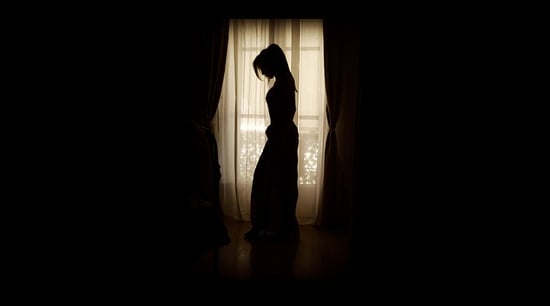
Imagine a world where women are fighting for unprecedented rights, the economic climate is unpredictable, and new developments in technology are made every year. While this world might sound like the present day, it also describes America in the 1890s .
It was in this world that author Kate Chopin wrote and lived, and many of the issues of the period are reflected in her short story, “The Story of an Hour.” Now, over a century later, the story remains one of Kate Chopin’s most well-known works and continues to shed light on the internal struggle of women who have been denied autonomy.
In this guide to Kate Chopin’s “The Story of an Hour,” we’ll discuss:
- A brief history of Kate Chopin and America the 1890s
- “The Story of an Hour” summary
- Analysis of the key story elements in “The Story of an Hour,” including themes, characters, and symbols
By the end of this article, you’ll have an expert grasp on Kate Chopin’s “The Story of an Hour.” So let’s get started!
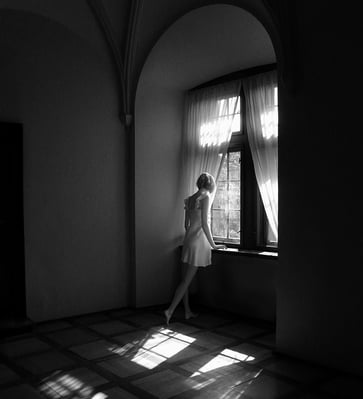
“The Story of an Hour” Summary
If it’s been a little while since you’ve read Kate Chopin’s “The Story of an Hour,” it can be hard to remember the important details. This section includes a quick recap, but you can find “The Story of an Hour” PDF and full version here . We recommend you read it again before diving into our analyses in the next section!
For those who just need a refresher, here’s “The Story of an Hour” summary:
Mrs. Louise Mallard is at home when her sister, Josephine, and her husband’s friend, Richards, come to tell her that her husband, Brently Mallard, has been killed in a railroad accident . Richards had been at the newspaper office when the news broke, and he takes Josephine with him to break the news to Louise since they’re afraid of aggravating her heart condition. Upon hearing the news of her husband’s death, Louise is grief-stricken, locks herself in her room, and weeps.
From here, the story shifts in tone. As Louise processes the news of her husband’s death, she realizes something wonderful and terrible at the same time: she is free . At first she’s scared to admit it, but Louise quickly finds peace and joy in her admission. She realizes that, although she will be sad about her husband (“she had loved him—sometimes,” Chopin writes), Louise is excited for the opportunity to live for herself. She keeps repeating the word “free” as she comes to terms with what her husband’s death means for her life.
In the meantime, Josephine sits at Louise’s door, coaxing her to come out because she is worried about Louise’s heart condition. After praying that her life is long-lived, Louise agrees to come out. However, as she comes downstairs, the front door opens to reveal her husband, who had not been killed by the accident at all. Although Richards tries to keep Louise’s heart from shock by shielding her husband from view, Louise dies suddenly, which the doctors later attribute to “heart disease—of the joy that kills .”
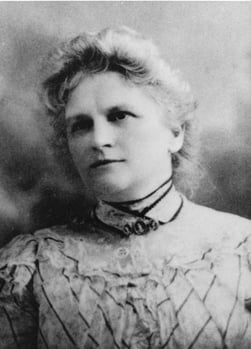
Kate Chopin, the author of "The Story of an Hour," has become one of the most important American writers of the 19th century.
The History of Kate Chopin and the 1890s
Before we move into “The Story of an Hour” analysis section, it’s helpful to know a little bit about Kate Chopin and the world she lived in.
A Short Biography of Kate Chopin
Born in 1850 to wealthy Catholic parents in St. Louis, Missouri, Kate Chopin (originally Kate O’Flaherty) knew hardship from an early age. In 1855, Chopin lost her father, Thomas, when he passed away in a tragic and unexpected railroad accident. The events of this loss would stay with Kate for the rest of her life, eventually becoming the basis for “The Story of an Hour” nearly forty years later.
Chopin was well-educated throughout her childhood , reading voraciously and becoming fluent in French. Chopin was also very aware of the divide between the powerful and the oppressed in society at the time . She grew up during the U.S. Civil War, so she had first-hand knowledge of violence and slavery in the United States.
Chopin was also exposed to non-traditional roles for women through her familial situation. Her mother, grandmother, and great-grandmother chose to remain widows (rather than remarry) after their husbands died. Consequently, Chopin learned how important women’s independence could be, and that idea would permeate much of her writing later on.
As Chopin grew older, she became known for her beauty and congeniality by society in St. Louis. She was married at the age of nineteen to Oscar Chopin, who came from a wealthy cotton-growing family. The couple moved to New Orleans, where they would start both a general store and a large family. (Chopin would give birth to seven children over the next nine years!)
While Oscar adored his wife, he was less capable of running a business. Financial trouble forced the family to move around rural Louisiana. Unfortunately, Oscar would die of swamp fever in 1882 , leaving Chopin in heavy debt and with the responsibility of managing the family’s struggling businesses.
After trying her hand at managing the property for a year, Chopin conceded to her mother’s requests to return with her children to St. Louis. Chopin’s mother died the year after. In order to support herself and her children, Kate began to write to support her family.
Luckily, Chopin found immediate success as a writer. Many of her short stories and novels—including her most famous novel, The Awakening— dealt with life in Louisiana . She was also known as a fast and prolific writer, and by the end of the 1900s she had written over 100 stories, articles, and essays.
Unfortunately, Chopin would pass away from a suspected cerebral hemorrhage in 1904, at the age of 54 . But Kate Chopin’s “The Story of an Hour” and other writings have withstood the test of time. Her work has lived on, and she’s now recognized as one of the most important American writers of the 19th century.
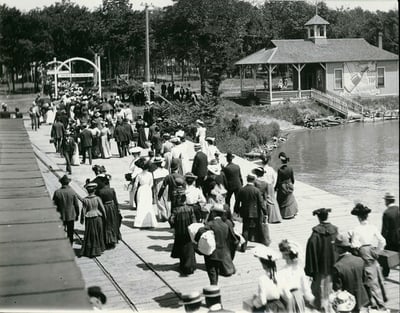
American life was undergoing significant change in the 19th century. Technology, culture, and even leisure activities were changing.
American Life in the 1890s
“The Story of an Hour” was written and published in 1894, right as the 1800s were coming to a close. As the world moved into the new century, American life was also changing rapidly.
For instance, t he workplace was changing drastically in the 1890s . Gone were the days where most people were expected to work at a trade or on a farm. Factory jobs brought on by industrialization made work more efficient, and many of these factory owners gradually implemented more humane treatment of their workers, giving them more leisure time than ever.
Though the country was in an economic recession at this time, technological changes like electric lighting and the popularization of radios bettered the daily lives of many people and allowed for the creation of new jobs. Notably, however, work was different for women . Working women as a whole were looked down upon by society, no matter why they found themselves in need of a job.
Women who worked while they were married or pregnant were judged even more harshly. Women of Kate Chopin’s social rank were expected to not work at all , sometimes even delegating the responsibility of managing the house or child-rearing to maids or nannies. In the 1890s, working was only for lower class women who could not afford a life of leisure .
In reaction to this, the National American Woman Suffrage Association was created in 1890, which fought for women’s social and political rights. While Kate Chopin was not a formal member of the suffragette movements, she did believe that women should have greater freedoms as individuals and often talked about these ideas in her works, including in “The Story of an Hour.”
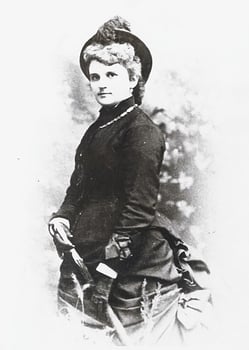
Kate Chopin's "The Story of an Hour" a short exploration of marriage and repression in America.
“The Story of an Hour” Analysis
Now that you have some important background information, it’s time to start analyzing “The Story of an Hour.”
This short story is filled with opposing forces . The themes, characters, and even symbols in the story are often equal, but opposite, of one another. Within “The Story of an Hour,” analysis of all of these elements reveals a deeper meaning.
“The Story of an Hour” Themes
A theme is a message explored in a piece of literature. Most stories have multiple themes, which is certainly the case in “The Story of an Hour.” Even though Chopin’s story is short, it discusses the thematic ideas of freedom, repression, and marriage.
Keep reading for a discussion of the importance of each theme!
Freedom and Repression
The most prevalent theme in Chopin’s story is the battle between freedom and “repression.” Simply put , repression happens when a person’s thoughts, feelings, or desires are being subdued. Repression can happen internally and externally. For example, if a person goes through a traumatic accident, they may (consciously or subconsciously) choose to repress the memory of the accident itself. Likewise, if a person has wants or needs that society finds unacceptable, society can work to repress that individual. Women in the 19th century were often victims of repression. They were supposed to be demure, gentle, and passive—which often went against women’s personal desires.
Given this, it becomes apparent that Louise Mallard is the victim of social repression. Until the moment of her husband’s supposed death, Louise does not feel free . In their marriage, Louise is repressed. Readers see this in the fact that Brently is moving around in the outside world, while Louise is confined to her home. Brently uses railroad transportation on his own, walks into his house of his own accord, and has individual possessions in the form of his briefcase and umbrella. Brently is even free from the knowledge of the train wreck upon his return home. Louise, on the other hand, is stuck at home by virtue of her position as a woman and her heart condition.
Here, Chopin draws a strong contrast between what it means to be free for men and women. While freedom is just part of what it means to be a man in America, freedom for women looks markedly different. Louise’s life is shaped by what society believes a woman should be and how a wife should behave. Once Louise’s husband “dies,” however, she sees a way where she can start claiming some of the more “masculine” freedoms for herself. Chopin shows how deeply important freedom is to the life of a woman when, in the end, it’s not the shock of her husband’s return of her husband that kills Louise, but rather the thought of losing her freedom again.
Marriage as a “The Story of an Hour” theme is more than just an idyllic life spent with a significant other. The Mallard’s marriage shows a reality of 1890s life that was familiar to many people. Marriage was a means of social control —that is to say, marriage helped keep women in check and secure men’s social and political power. While husbands were usually free to wander the world on their own, hold jobs, and make important family decisions, wives (at least those of the upper class) were expected to stay at home and be domestic.
Marriage in Louise Mallard’s case has very little love. She sees her marriage as a life-long bond in which she feels trapped, which readers see when she confesses that she loved her husband only “sometimes.” More to the point, she describes her marriage as a “powerful will bending hers in that blind persistence with which men and women believe they have a right to impose a private will upon a fellow-creature.” In other words, Louise Mallard feels injustice in the expectation that her life is dictated by the will of her husband.
Like the story, the marriages Kate witnessed often ended in an early or unexpected death. The women of her family, including Kate herself, all survived their husbands and didn’t remarry. While history tells us that Kate Chopin was happy in her marriage, she was aware that many women weren’t. By showing a marriage that had been built on control and society’s expectations, Chopin’s “The Story of an Hour” highlights the need for a world that respected women as valuable partners in marriage as well as capable individuals.
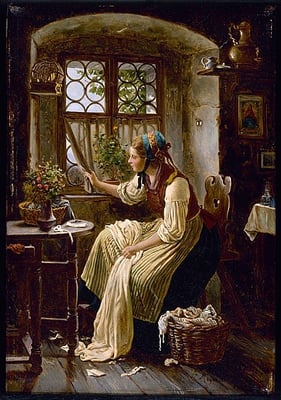
While this painting by Johann Georg Meyer wasn't specifically of Louise Mallard, "Young Woman Looking Through a Window" is a depiction of what Louise might have looked like as she realized her freedom.
"The Story of an Hour" Characters
The best stories have developed characters, which is the case in “The Story of an Hour,” too. Five characters make up the cast of “The Story of an Hour”:

Louise Mallard
Brently mallard.
- The doctor(s)
By exploring the details of each character, we can better understand their motivations, societal role, and purpose to the story.
From the opening sentence alone, we learn a lot about Louise Mallard. Chopin writes, “Knowing that Mrs. Mallard was afflicted with a heart trouble, great care was taken to break to her as gently as possible the news of her husband’s death.”
From that statement alone, we know that she is married, has a heart condition, and is likely to react strongly to bad news . We also know that the person who is sharing the bad news views Louise as delicate and sensitive. Throughout the next few paragraphs, we also learn that Louise is a housewife, which indicates that she would be part of the middle-to-upper class in the 1890s. Chopin also describes Louise’s appearance as “young,” “fair, calm face,” with lines of “strength.” These characteristics are not purely physical, but also bleed into her character throughout the story.
Louise’s personality is described as different from other women . While many women would be struck with the news in disbelief, Louise cries with “wild abandonment”—which shows how powerful her emotions are. Additionally, while other women would be content to mourn for longer, Louise quickly transitions from grief to joy about her husband’s passing.
Ultimately, Chopin uses Louise’s character to show readers what a woman’s typical experience within marriage was in the 1890s. She uses Louise to criticize the oppressive and repressive nature of marriage, especially when Louise rejoices in her newfound freedom.
Josephine is Louise’s sister . We never hear of Josephine’s last name or whether she is married or not. We do know that she has come with Richards, a friend of Brently’s, to break the news of his death to her sister.
When Josephine tells Louise the bad news, she’s only able to tell Louise of Brently’s death in “veiled hints,” rather than telling her outright. Readers can interpret this as Josephine’s attempt at sparing Louise’s feelings. Josephine is especially worried about her sister’s heart condition, which we see in greater detail later as she warns Louise, “You will make yourself ill.” When Louise locks herself in her room, Josephine is desperate to make sure her sister is okay and begs Louise to let her in.
Josephine is the key supporting character for Louise, helping her mourn, though she never knows that Louise found new freedom from her husband’s supposed death . But from Josephine’s actions and interactions with Louise, readers can accurately surmise that she cares for her sister (even if she’s unaware of how miserable Louise finds her life).
Richards is another supporting character, though he is described as Brently’s friend, not Louise’s friend. It is Richards who finds out about Brently Mallard’s supposed death while at the newspaper office—he sees Brently’s name “leading the list of ‘killed.’” Richards’ main role in “The Story of an Hour” is to kick off the story’s plot.
Additionally, Richard’s presence at the newspaper office suggests he’s a writer, editor, or otherwise employee of the newspaper (although Chopin leaves this to readers’ inferences). Richards takes enough care to double-check the news and to make sure that Brently’s likely dead. He also enlists Josephine’s help to break the news to Louise. He tries to get to Louise before a “less careful, less tender friend” can break the sad news to her, which suggests that he’s a thoughtful person in his own right.
It’s also important to note is that Richards is aware of Louise’s heart condition, meaning that he knows Louise Mallard well enough to know of her health and how she is likely to bear grief. He appears again in the story at the very end, when he tries (and fails) to shield Brently from his wife’s view to prevent her heart from reacting badly. While Richards is a background character in the narrative, he demonstrates a high level of friendship, consideration, and care for Louise.

Brently Mallard would have been riding in a train like this one when the accident supposedly occurred.
Mr. Brently Mallard is the husband of the main character, Louise. We get few details about him, though readers do know he’s been on a train that has met with a serious accident. For the majority of the story, readers believe Brently Mallard is dead—though the end of “The Story of an Hour” reveals that he’s been alive all along. In fact, Brently doesn’t even know of the railroad tragedy when he arrives home “travel-stained.”
Immediately after Louise hears the news of his death, she remembers him fondly. She remarks on his “kind, tender hands” and says that Brently “never looked save with love” upon her . It’s not so much Brently as it’s her marriage to him which oppresses Louise. While he apparently always loved Louise, Louise only “sometimes” loved Brently. She constantly felt that he “impose[d] a private will” upon her, as most husbands do their wives. And while she realizes that Brently likely did so without malice, she also realized that “a kind intention or a cruel intention” makes the repression “no less a crime.”
Brently’s absence in the story does two things. First, it contrasts starkly with Louise’s life of illness and confinement. Second, Brently’s absence allows Louise to imagine a life of freedom outside of the confines of marriage , which gives her hope. In fact, when he appears alive and well (and dashes Louise’s hopes of freedom), she passes away.
The Doctor(s)
Though the mention of them is brief, the final sentence of the story is striking. Chopin writes, “When the doctors came they said she had died of heart disease—of the joy that kills.” Just as she had no freedom in life, her liberation from the death of her husband is told as a joy that killed her.
In life as in death, the truth of Louise Mallard is never known. Everything the readers know about her delight in her newfound freedom happens in Louise’s own mind; she never gets the chance to share her secret joy with anyone else.
Consequently, the ending of the story is double-sided. If the doctors are to be believed, Louise Mallard was happy to see her husband, and her heart betrayed her. And outwardly, no one has any reason to suspect otherwise. Her reaction is that of a dutiful, delicate wife who couldn’t bear the shock of her husband returned from the grave.
But readers can infer that Louise Mallard died of the grief of a freedom she never had , then found, then lost once more. Readers can interpret Louise’s death as her experience of true grief in the story—that for her ideal life, briefly realized then snatched away.

In "The Story of an Hour," the appearance of hearts symbolize both repression and hope.
“The Story of an Hour” Symbolism and Motifs
Symbols are any object, word, or other element that appear in the story and have additional meanings beyond. Motifs are elements from a story that gain meaning from being repeated throughout the narrative. The line between symbols and motifs is often hazy, but authors use both to help communicate their ideas and themes.
In “The Story of an Hour,” symbolism is everywhere, but the three major symbols present in the story are:
- The heart
- The house and the outdoors
- Joy and sorrow
Heart disease, referred to as a “heart condition” within the text, opens and closes the text. The disease is the initial cause for everyone’s concern, since Louise’s condition makes her delicate. Later, heart disease causes Louise’s death upon Brently’s safe return. In this case, Louise’s ailing heart has symbolic value because it suggests to readers that her life has left her heartbroken. When she believes she’s finally found freedom, Louise prays for a long life...when just the day before, she’d “had thought with a shudder that life might be long.”
As Louise realizes her freedom, it’s almost as if her heart sparks back to life. Chopin writes, “Now her bosom rose and fell tumultuously...she was striving to beat it back...Her pulses beat fast, and the coursing blood warmed and relaxed every inch of her body.” These words suggest that, with her newfound freedom, the symptoms of her heart disease have lifted. Readers can surmise that Louise’s diseased heart is the result of being repressed, and hope brings her heart back to life.
Unfortunately, when Brently comes back, so does Louise’s heart disease. And, although her death is attributed to joy, the return of her (both symbolic and literal) heart disease kills her in the end.
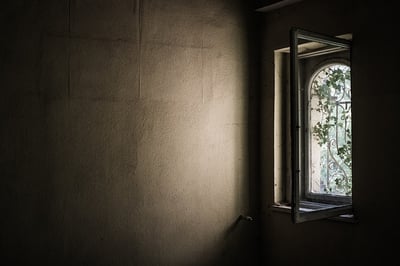
The House and the Outdoors
The second set of symbols are Louise’s house and the world she can see outside of her window. Chopin contrasts these two symbolic images to help readers better understand how marriage and repression have affected Louise.
First of all, Louise is confined to the home—both within the story and in general. For her, however, her home isn’t a place to relax and feel comfortable. It’s more like a prison cell. All of the descriptions of the house reinforce the idea that it’s closed off and inescapable . For instance, the front door is locked when Mr. Mallard returns home. When Mrs. Mallard is overcome with grief, she goes deeper inside her house and locks herself in her room.
In that room, however, Mrs. Mallard takes note of the outdoors by looking out of her window. Even in her momentary grief, she describes the “open square before her house” and “the new spring life.” The outdoors symbolize freedom in the story, so it’s no surprise that she realizes her newfound freedom as she looks out her window. Everything about the outside is free, beautiful, open, inviting, and pleasant...a stark contrast from the sadness inside the house .
The house and its differences from outdoors serve as one of many symbols for how Louise feels about her marriage: barred from a world of independence.
Joy and Sorrow
Finally, joy and sorrow are motifs that come at unexpected times throughout “The Story of an Hour.” Chopin juxtaposes joy and sorrow to highlight how tragedy releases Louise from her sorrow and gives her a joyous hope for the future.
At first, sorrow appears as Louise mourns the death of her husband. Yet, in just a few paragraphs, she finds joy in the event as she discovers a life of her own. Though Louise is able to see that feeling joy at such an event is “monstrous,” she continues to revel in her happiness.
It is later that, when others expect her to be joyful, Josephine lets out a “piercing cry,” and Louise dies. Doctors interpret this as “the joy that kills,” but more likely it’s a sorrow that kills. The reversal of the “appropriate” feelings at each event reveals how counterintuitive the “self-assertion which she suddenly recognized as the strongest impulse of her being” is to the surrounding culture. This paradox reveals something staggering about Louise’s married life: she is so unhappy with her situation that grief gives her hope...and she dies when that hope is taken away.
Key Takeaways: Kate Chopin's “The Story of an Hour”
Analyzing Chopin’s “The Story of an Hour” takes time and careful thought despite the shortness of the story. The story is open to multiple interpretations and has a lot to reveal about women in the 1890s, and many of the story’s themes, characters, and symbols critique women’s marriage roles during the period .
There’s a lot to dig through when it comes to “The Story of an Hour” analysis. If you’re feeling overwhelmed, just remember a few things :
- Events from Kate Chopin’s life and from social changes in the 1890s provided a strong basis for the story.
- Mrs. Louise Mallard’s heart condition, house, and feelings represent deeper meanings in the narrative.
- Louise goes from a state of repression, to freedom, and then back to repression, and the thought alone is enough to kill her.
Remembering the key plot points, themes, characters, and symbols will help you write any essay or participate in any discussion. Kate Chopin’s “The Story of an Hour” has much more to uncover, so read it again, ask questions, and start exploring the story beyond the page!

What’s Next?
You may have found your way to this article because analyzing literature can be tricky to master. But like any skill, you can improve with practice! First, make sure you have the right tools for the job by learning about literary elements. Start by mastering the 9 elements in every piece of literature , then dig into our element-specific guides (like this one on imagery and this one on personification .)
Another good way to start practicing your analytical skills is to read through additional expert guides like this one. Literary guides can help show you what to look for and explain why certain details are important. You can start with our analysis of Dylan Thomas’ poem, “Do not go gentle into that good night.” We also have longer guides on other words like The Great Gatsby and The Crucible , too.
If you’re preparing to take the AP Literature exam, it’s even more important that you’re able to quickly and accurately analyze a text . Don’t worry, though: we’ve got tons of helpful material for you. First, check out this overview of the AP Literature exam . Once you have a handle on the test, you can start practicing the multiple choice questions , and even take a few full-length practice tests . Oh, and make sure you’re ready for the essay portion of the test by checking out our AP Literature reading list!

Ashley Sufflé Robinson has a Ph.D. in 19th Century English Literature. As a content writer for PrepScholar, Ashley is passionate about giving college-bound students the in-depth information they need to get into the school of their dreams.
Student and Parent Forum
Our new student and parent forum, at ExpertHub.PrepScholar.com , allow you to interact with your peers and the PrepScholar staff. See how other students and parents are navigating high school, college, and the college admissions process. Ask questions; get answers.

Ask a Question Below
Have any questions about this article or other topics? Ask below and we'll reply!
Improve With Our Famous Guides
- For All Students
The 5 Strategies You Must Be Using to Improve 160+ SAT Points
How to Get a Perfect 1600, by a Perfect Scorer
Series: How to Get 800 on Each SAT Section:
Score 800 on SAT Math
Score 800 on SAT Reading
Score 800 on SAT Writing
Series: How to Get to 600 on Each SAT Section:
Score 600 on SAT Math
Score 600 on SAT Reading
Score 600 on SAT Writing
Free Complete Official SAT Practice Tests
What SAT Target Score Should You Be Aiming For?
15 Strategies to Improve Your SAT Essay
The 5 Strategies You Must Be Using to Improve 4+ ACT Points
How to Get a Perfect 36 ACT, by a Perfect Scorer
Series: How to Get 36 on Each ACT Section:
36 on ACT English
36 on ACT Math
36 on ACT Reading
36 on ACT Science
Series: How to Get to 24 on Each ACT Section:
24 on ACT English
24 on ACT Math
24 on ACT Reading
24 on ACT Science
What ACT target score should you be aiming for?
ACT Vocabulary You Must Know
ACT Writing: 15 Tips to Raise Your Essay Score
How to Get Into Harvard and the Ivy League
How to Get a Perfect 4.0 GPA
How to Write an Amazing College Essay
What Exactly Are Colleges Looking For?
Is the ACT easier than the SAT? A Comprehensive Guide
Should you retake your SAT or ACT?
When should you take the SAT or ACT?
Stay Informed
Get the latest articles and test prep tips!
Looking for Graduate School Test Prep?
Check out our top-rated graduate blogs here:
GRE Online Prep Blog
GMAT Online Prep Blog
TOEFL Online Prep Blog
Holly R. "I am absolutely overjoyed and cannot thank you enough for helping me!”
The Story of an Hour Plot Analysis
Most good stories start with a fundamental list of ingredients: the initial situation, conflict, complication, climax, suspense, denouement, and conclusion. great writers sometimes shake up the recipe and add some spice., initial situation, mrs. mallard has a weak heart..
This is the setup we need to know for all the events to come, as well as being a piece of characterization. The fact that Mrs. Mallard has a weak heart changes the way everybody has to behave to her. She has to be handled gently so that her heart doesn't get a shock. Just in case we forget, should she get a shock at any point, she could die. This results in instant and constant dramatic tension.
Mr. Mallard dies and Mrs. Mallard's friends have to break the news to her gently.
Not only has her husband died, Mrs. Mallard could very well die too upon hearing the news. His death puts them both in danger. Mrs. Mallard's friends have to take special care in letting her know what happened so that she doesn't die also.
Complication
Mrs. mallard mourns and tries to deal with her unusual feelings..
In the case of this story, the complication stage itself embodies the idea of complicated. We'll explain: Mrs. Mallard complicates the traditional or expected reaction of a widow to a husband's death by reacting in a totally unusual way. Instead of refusing to believe the news or take it in, she instantly grasps it and cries her eyes out, before going off to be alone. All this is meant to show us that she's an unusual widow, and it prepares us for the climax to follow.
Mrs. Mallard declares that she is free.
Mrs. Mallard struggles with her grief, and then also struggles with a piece of new knowledge coming at her. She tries to avoid it, but can't completely push it off. Finally, she succumbs to the realization that she is free, and that she's glad. After the tragedy of hearing such bad news, and managing such changing emotions of grief and abandonment, Mrs. Mallard is so overwhelmed by her feeling of freedom that she can barely whisper.
Mrs. Mallard comes out of her room, meets her sister, and starts to go down the stairs.
Mrs. Mallard floats out of her room on the crest of Victory, feeling like she's conquered her sadness, her non-sadness, and her new desire for freedom. She sweeps out of her room like a new person, stronger for her grief, and excited about her life ahead. She's almost high with all the emotion and adrenaline floating about her as she keeps fixating on the idea that she's free at last.
Mr. Mallard walks in, far from dead, shocking everyone.
Suddenly, a totally unexpected thing happens: Mr. Mallard comes home. Everyone's shocked, except Mr. Mallard, who has no idea of what's been going on. Even though Josephine and Richards are surprised too, they try to keep Mrs. Mallard from receiving the shock. But they can't. As if getting a shock wouldn't be hard enough on her heart, she's got all these emotions and excitement about freedom running through her body.
Doctors say Mrs. Mallard died of joy.
We readers have to piece together the fact that Mrs. Mallard has died based on what we know about her (the weak heart), her shock on seeing Mr. Mallard, and the narrator's dry statement that Richards couldn't prevent her new shock. Between that and the doctors' explanation for her death, we realize that Mrs. Mallard has passed away. Unlike her husband's death in the train accident, there's no room for error or miscommunication there. She can't return. The events foreshadowed in the "Initial Situation" have come true.
Tired of ads?
Cite this source, logging out…, logging out....
You've been inactive for a while, logging you out in a few seconds...
W hy's T his F unny?
Story Of An Hour Rhetorical Analysis Essay
The Story of An Hour Marriage is seen as a partnership where wives and husbands are seen as equal; however, in the 19th century, women were bound to their marriage. What happens when they get a taste of freedom? Louise Mallard is in a traditional marriage when she receives the news of her husband’s passing and begins the process of grief and a new sense of freedom. In Chopin’s story, “The Story of An Hour”, Chopin uses imagery, repetition, and irony to portray Mrs. Mallard’s journey of discovering freedom after her husband’s death. Using the five senses to create a vivid image, the imagery device is present to portray the surroundings of Mrs. Mallard and how they contribute to her journey of freedom. In paragraphs 5 and 6, Chopin uses imagery to describe the outside surroundings of …show more content…
Mallard values the freedom that has been given to her. The word “free” is one of the words that is outspoken and recurrent to emphasize the emotions that Mrs. Mallard experiences. Another repetition is in paragraph 14 to emphasize the emotion of freedom as Mrs. Mallard’s life begins to begin, “Free! Body and soul free!” (Chopin 1894, paragraph 14). The use of repetition emphasizes the view that Mrs. Mallard sees her life as starting to begin, as the whispering of the word “free” signals the new journey. In addition to the devices of imagery and repetition being present in the story, irony plays a role as situational irony. In the last two paragraphs, Chopin uses situational irony to reveal that Mr. Mallard is alive all long, “It was Brently Mallard who entered, a little travel-stained, carrying his grip-sack and umbrella. He had been far from the scene of the accident, and did not even know there had been one. He stood amazed at Josephine's piercing cry; at Richards' quick motion to screen him from the view of his wife. When the doctors came they said she had died of heart disease—of the joy that kills.” (Chopin 1894, paragraph
More about Story Of An Hour Rhetorical Analysis Essay
Ripley review: Andrew Scott is the diabolical conman Tom Ripley in this arthouse adaptation
In high school I struggled to cut my writing homework for English literature down and would routinely hand in essays that were hundreds of words over the limit.
I argued that my teacher should be happy I was giving them more than they asked for.
His response went a little like: "Not when everyone else has managed to get out what they wanted to say, using fewer words and taking less of my time."
This is Ripley's problem. Its director, writer and producer, Steve Zaillian, would have you watch 7.8 hours worth of television to tell a version of a story that Anthony Minghella (most notable of the six Ripley adaptations) managed to tell 25 years ago with a two-hour movie.
Andrew Scott (Fleabag, All of Us Strangers ) leads this iteration as Tom Ripley, a duplicitous con man whom we first meet masquerading as a debt collector who, barely scraping by, in 1960s New York.
As in previous versions of the story, Tom needs little convincing when a wealthy man wants to pay him to travel to Italy and convince his rich and spoiled dilettante son Dickie Greenleaf (Johnny Flynn) to return to the US.
Tom is instantly enamoured by Dickie's life — consisting of lazily adding haphazard brushstrokes to mediocre paintings and relaxing on his Amalfi coast-moored boat with his girlfriend Marge Sherwood (Dakota Fanning), who is trying and failing to write an Eat, Pray, Love-style book. Which is to say, "they do nothing".
Tom's desperation to cling to the life his proximity to Dickie affords him results in murder, deceit and fraud. (Yes, the parallels to the recent Saltburn are striking.)
In the age of streaming, Ripley is by no means the first adaptation with a blown-out run time. But the decisions from other directors to tell familiar stories over the course of several episodes instead of in a single film (most recently Mr and Mrs Smith ) have been justified by their additions to source material.
Ripley, however, subtracts key elements from the classic movie starring Matt Damon, Jude Law and Gwyneth Paltrow. And it confines itself to telling the story of only the first of the five Patricia Highsmith novels that comprise the Ripley series. (Perhaps because Zaillian doesn't plan for this limited series to remain limited? Not that we have any indication of this, beyond the fact the show was named after the series as opposed to its first book, The Talented Mr Ripley.)
The reason Ripley is so long despite its comparatively thin narrative is because it leans painstakingly into the conventions of the psychological thriller genre, drawing out the minutiae of Tom's every movement and experience — partly to create an intoxicating visual world, but mostly to foster a sense of unease.
In this way, something that would seem simple and mundane in another context, like the sound of an elevator ascending, becomes anxiety-inducing.
It's incredibly effective at building glorious tension. But, over so many episodes, it's also exhausting.
As is Zaillian's decision to tell this story in black and white. Don't bother waiting for a mid-way transition to colour à la Poor Things — it isn't coming.
"The edition of the Ripley book I had on my desk had an evocative black and white photograph on the cover," Zaillian said of his decision in Vanity Fair last year. "As I was writing, I held that image in my mind. Black and white fits this story — and it's gorgeous."
There are moments when Zaillian's decision feels so fitting. For one, it lends a beady quality to Scott's eyes, which helps emphasise that this version of Tom is less morally grey. He's older (Scott is 47), beaten down from a life of poverty, visibly slimy and set in his scheming ways. (Yet somehow still attractive, because Scott is out here giving Hot Priest in everything he does.)
And in Zaillian's monochrome world, the use of light can be equal-parts transfixing and anxiety inducing — whether it's dancing on the fur of a watchful cat or flashing across the eyes of a suspicious taxi driver.
But, despite this aesthetic appeal, there are more moments when the decision to go full black-and-white is irritating.
And part of what makes both Highsmith's original story and the 1999 film so psychologically thrilling is that they play out in the decadently beautiful dreamscape that is the Amalfi coast in the 1960s. In those tellings, the incongruence of the dark events that take place within the vibrant setting were key. But, in Ripley, things start off dark and stay dark.
Colour is lacking in more than just the literal sense, too. While Fanning is perfectly suspicious as Marge, and Flynn makes for a brilliant choice as the charismatic Dickie, there's something missing in the chemistry of their relationship. Tom and Dickie's friendship doesn't feel genuine, either — Flynn isn't carefree enough and Scott isn't youthfully exuberant enough for it to be entirely plausible after the orchestration of their meeting is revealed.
And, somehow, all three characters are less rounded than they have been in previous versions of this story — none more so than our protagonist. We don't get overt glimpses at Tom's self-awareness as we did in the 1999 film when Damon quietly posited:
"Whatever you do, however terrible, however hurtful, it all makes sense, doesn't it? In your head? You never meet anybody who thinks they're a bad person."
Maybe that's because Scott's version of Tom has even less to lose than the Tom Ripleys that came before him. Maybe it's because Ripley is trying to be cerebral and show, rather than tell, absolutely everything — from the chore that is mopping up blood, to what happens when you accidentally leave key evidence at a crime scene and have to double back for it.
That could also go some way to explaining the repeated visual parallels drawn between the Italian painter/murderer Caravaggio and Tom throughout the series, which was Zaillian's addition to the story.
But for what Ripley leaves out from Tom, Marge and Dickie's narratives, it adds immeasurably to its background characters. Italian actor Maurizio Lombardi is a stand-out as weary police inspector Pietro Ravini, as are the string of observant hotel concierges whose delightful expressiveness screams the extent to which they see through Tom.
And then there's Freddie Miles — Dickie's impossibly exhausting trust-fund-baby friend — refreshingly portrayed here by real-life trust-fund baby Eliot Sumner (whose parents are Sting and Trudie Styler). Their decision not to emulate the late Philip Seymour Hoffman's iconic version of Freddie is commendable.
Surprisingly, there are several moments of hilarity in Ripley; there are even darkly humorous moments in the wake of cold-blooded murders.
But each of these gags pale in comparison to the highly satisfying ending — which happens to be less wrenching than that of the 1999 film, and more exciting than the book.
(Ironically, I have gone over the word limit for this review.)
Ripley is streaming now on Netflix.
- X (formerly Twitter)
Related Stories
Dev patel goes for broke as a vicious underdog filled with righteous fury in his directorial debut.
Michelle Yeoh and Sandra Oh star in The Tiger's Apprentice, a fantasy film about the Chinese Zodiac
Prince Andrew's disastrous interview is only '5 per cent' of the story. Scoop tells the rest
- United States

The Story of an Hour
Kate chopin, everything you need for every book you read., brently mallard quotes in the story of an hour.
What could love, the unsolved mystery, count for in face of this possession of self-assertion which she suddenly recognized as the strongest impulse of her being!

COMMENTS
An intelligent, independent woman, Louise Mallard understands the "right" way for women to behave, but her internal thoughts and feelings are anything but correct. When her sister announces that Brently has died, Louise cries dramatically rather than feeling numb, as she knows many other women would. Her violent reaction immediately shows ...
Character Analysis. Mrs. Mallard is the character we know the most about by far. Of course, that's not saying much. She's the protagonist, the center of attention, and the person around whom all the other characters revolve. At the beginning of the story, when Mr. Mallard dies, the other characters (Richards and Josephine) put aside their ...
Brently Mallard. A woman troubled by a heart condition who is told that her husband, Brently Mallard, has died in a train accident. Due to her heart problem, she is not supposed to become overly excited, but—unlike how other women of the time period might react—she responds to this bad news with intense, wild grief.
In conclusion, The Story of an Hour is a thought-provoking and controversial short story that explores themes of freedom, identity, and the limitations placed upon women in the late 19th century.Through the character of Mrs. Mallard, Kate Chopin challenges societal norms and highlights the desire for independence and self-fulfillment that many women felt during this time period.
Louise Mallard: The main character in Chopin's short story, Louise exhibits an apparent contradiction in her character from the beginning: She weeps wildly when she gets the news of her husband's death, and readers aren't given any reason to doubt that her tears are genuine. However, moments later she is overtaken by a clear, strong feeling of joy at the freedom that her husband's death ...
Louise Mallard. A woman troubled by a heart condition who is told that her husband, Brently Mallard, has died in a train accident. Due to her heart problem, she is not supposed to become overly excited… read analysis of Louise Mallard.
The Story of an Hour Characters. T he main characters in "The Story of an Hour" are Louise Mallard, Brently Mallard, and Louise's sister Josephine.. Louise Mallard is a young woman who suffers ...
Mrs. Louise Mallard had a good marriage according to societal norms. Her husband appeared to love her and she seemed to return his love. She did her duty as a wife, which meant submitting her will to the will of her husband. However, Louise's true self was stifled by her marriage. The sudden death of her husband, though, gives her the freedom ...
In "The Story of an Hour," Mrs. Mallard exhibits three primary character traits: dutifulness, naivety, and passion. As a dutiful wife, she initially grieves her husband's supposed death. Her ...
After her initial sobs of grief subside, Louise escapes into her bedroom and locks the door. She refuses to let Josephine or Richards follow her. Alone, she falls into a chair placed before an open window. Absolutely drained by her own anguish and haunted by exhaustion, she rests in the chair and looks out the window.
In "The Story of an Hour," why is the character Louise often referred to as "Mrs. Mallard"? Is Mrs. Mallard in "The Story of an Hour" a round or flat character? In "The Story of an Hour," does Mrs ...
Josephine: Louise Mallard's sister, who breaks the news of Brently Mallard's death to his wife. Josephine holds her sister while she weeps with "with sudden, wild abandonment," and implores Mrs. Mallard to come out when she retreats to her room to contemplate the situation. Richards: Brently Mallard's friend. He was in the newspaper office when ...
The Story of an Hour Characters. Mrs. Louise Mallard ; Mrs. Louise Mallard is the protagonist of the story. Si introduced as being "afflicted with a heart trouble", which is who great care is taken in telling her of her husband's death. She mour her husband, but then begins to feel relieved and liberated. Mr. Brently Mallard
English 4C Character Analysis Mrs. Mallard is a character from the short story "Story of an Hour" by Kate Chopin. "Story of an Hour" outlines the conflict back when society didn't accept divorced women, but it accepted widows and we realize that being a widow is the only way for Mrs. Mallard to achieve freedom.
Author: William Anderson (Schoolworkhelper Editorial Team) Louise Mallard in the Story of an Hour is a great example of a tragic hero, because of her strange reaction to being newly widowed. Louise's reaction to Brently's death is unusual compared to how a stereotypical widowed woman's grief would be. This coordinates quite well with the ...
In this guide to Kate Chopin's "The Story of an Hour," we'll discuss: A brief history of Kate Chopin and America the 1890s. "The Story of an Hour" summary. Analysis of the key story elements in "The Story of an Hour," including themes, characters, and symbols. By the end of this article, you'll have an expert grasp on Kate ...
Full Plot Analysis. As the brief nature of the story suggests, "The Story of an Hour" explores the sudden struggle that Louise Mallard faces as she reaches a major turning point in her life. The possibilities that exist in a world without her husband captivate her, but she also experiences guilt regarding the relief she feels after hearing ...
Mrs. Mallard comes out of her room, meets her sister, and starts to go down the stairs. Mrs. Mallard floats out of her room on the crest of Victory, feeling like she's conquered her sadness, her non-sadness, and her new desire for freedom. She sweeps out of her room like a new person, stronger for her grief, and excited about her life ahead.
The goal of Louise Mallard in "The Story of an Hour" is probably best expressed as freedom or liberation. When she believes that her husband is dead, she feels no grief but is profoundly relieved ...
Louise Mallard is in a traditional marriage when she receives the news of her husband's passing and begins the process of grief and a new sense of freedom. In Chopin's story, "The Story of An Hour", Chopin uses imagery, repetition, and irony to portray Mrs. Mallard's journey of discovering freedom after her husband's death.
In high school I struggled to cut my writing homework for English literature down and would routinely hand in essays that were hundreds of words over the limit. His response went a little like ...
Brently Mallard. Brently Mallard, Louise's husband, plays an extensive role in "The Story of an Hour" even though he only appears physically in the last moments of the narrative. His supposed death serves as the catalyst for Louise's entire emotional arc, and his return home symbolizes the broader persistence of patriarchal values and ...
Brently Mallard Character Analysis. Brently Mallard. Louise Mallard 's husband, who is incorrectly reported to have died in a train accident. When he returns home that day, he has no idea that anybody thinks he has died. Brently is a kind and loving husband to Louise, but despite that is an impediment to Louise's freedom simply through the ...